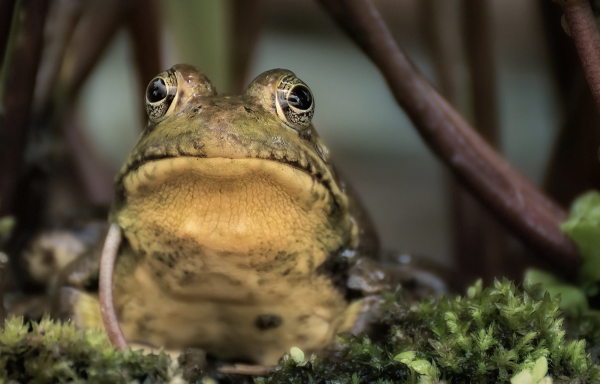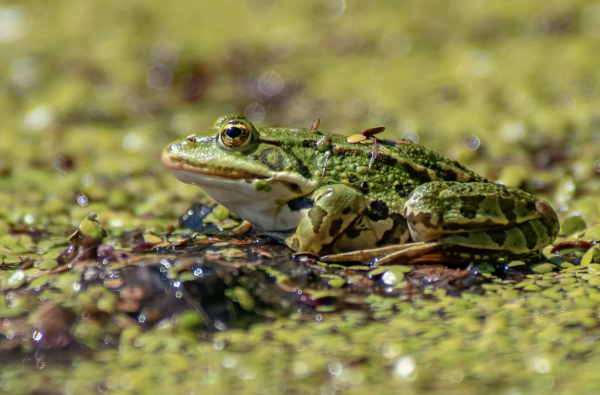The ancestors of modern frogs existed during the age of dinosaurs. In fact, the remains of the first four-legged fish (prehistoric ancestor of frogs) reveal that it existed 370 million years before. The name of this creature is Ichthyostega and it lived during Devonian epoch. In other words, frogs date back to more than 200 million years. Now before we deep dive into what do frogs eat in the rainforest, let’s explore a little bit about this amphibian.
Among land animals, they were arguably the first ones to have vocal cords. With more than 6,000 known species, frogs have worldwide distribution thanks to their amazing ability to acclimatized themselves to just about anywhere. They account for pretty much 90 percent of the extant species of amphibians.

American Bullfrog (Lithobates catesbeianus). Photo © Robert Zunikoff
Frogs are one of those amphibians that may respond even to the slight changes in environment. That’s why they are known as indicator species (along with toads and salamanders).
There is a huge diversity in the size of various species of frogs. On a large scale, Goliath frog is the largest frog in the world with the size of up to 15 inches. On the contrary, there is a vest-pocket frog called Cuban tree toad, which can be around half an inch long. Now before we deep dive into what do frogs eat in a pond, first let’s take a brief rundown on these tailless amphibians.
They have excellent eyesight. They usually thrive in freshwater. Frogs don’t have to drink because they absorb water through their skin. There is actually a circle behind the eye of a frog which may be small or large depending upon the size. This is the frog’s inner ear and it is known as tympanum. They can make very loud sounds but without doing any harm to their eardrums. This is because the frog’s eardrum is connected to the lungs. At the lower side of the frog’s thighs as well as on their bellies, there is a region called ‘drinking patch’. Frogs tend to absorb water through this area of their skin.
We often see some frogs having balloons of air-filled skin, known as vocal sacs. These are male frogs and we can hear some of these sounds from as far as a mile away. They can hop over as high as 20 times the length of their bodies, thanks to their long legs.

Northern Leopard Frog (Lithobates pipiens). Photo © Wynand van Poortvliet
During freezing months, they tend to dig burrows underground and hibernate until spring. Some frog species can survive in extreme cold weathers while others are expert desert dwellers.
For instance, almost 65 percent of the wood frog’s body freezes solid in the north of the Arctic Circle. Despite that, this frog can cling to life for weeks. Likewise, the Australian water-holding frog burrows underground in the desert. Amazingly, this frog can stick around for up to seven years, hoping for a shower of rain.
A toad is certainly a frog, but a frog is not necessarily a toad. Like toads, frogs belong to the same order Anura. But there is a family of frogs known as Ranidae, which contains at least 600 species. The members of this family are called ‘true frogs’. However, unlike toads, frogs tend to have long legs and smooth, moist skin. Moreover, they have bulging eyes, webbed feet and no tail.
What Do Frogs Eat in the Rainforest
Frogs will scarf down just about any living thing unless it doesn’t fit into their mouths at all. However, they usually live off small invertebrates like worms, slugs, spiders, larvae, and insects.
Some larger species may gulp down fish, small mammals (like small rodents), and even other frogs.
There are some frog species (like Brazilian tree frogs) that tuck into plant matter as well as fruits.
An American bullfrog, a large true frog, is found to snarf down larger prey items such as mice, small turtles, frogs, and even small snakes.

True Frog (Ranidae). Photo © Darko Pribeg
They tend to grab their prey by means of their sticky tongue, which snaps back at super speed with the meal.
Some species devour food by using their hands due to their lack of tongue. In such cases, they gobble up by pushing the food down the throat through their eyes.
Frogs deposit their eggs as clumps of thousands (called frogspawn). They place these eggs in quiet fresh water and are protected by a jelly-like substance. Once the eggs are hatched, these free-swimming larvae (known as tadpoles) stay in water. However, most tadpoles often get eaten by predators like newts and kingfishers.
Most tadpoles are herbivores and they graze on free-floating vegetation such as algae. That said, there are some tadpoles that consume tiny fish, insects, and tadpoles.
Sources & Further Reading:
Tesler, P. (1999). “The amazing adaptable frog“. Exploratorium:: The museum of science, art and human perception.
Duellman, William E. and Zug, George R.. “Anura“. Encyclopedia Britannica, 30 May. 2020
“Frog Fun Facts“. American Museum of Natural History.
“Frog and Toad“. San Diego Zoo.
Tesler, Pearl. “The Amazing Adaptable Frog“. The Exploratorium.
Welch, Shannon. “Amphibians“. Defenders of Wildlife.
“All About Frogs“. Burke Museum.
